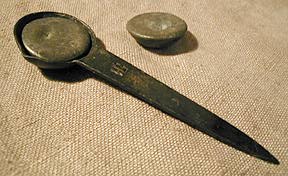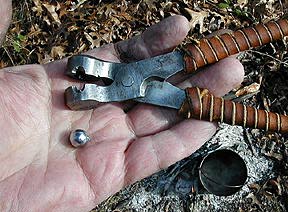

One of the most fun things I do in camp is make my own lead round balls. It is a simple thing, but I find it very satisfying. I suppose our forebears would have been amused to think of making lead balls as entertainment, and it certainly isn't far up on the list of old time skills which are difficult to preserve. Still, it pleasures me to see a ball I made over the campfire strike true on the target, whether it is just a mark on an old stump or is my supper. They will do that, too. I find them to be as accurate for my hunting and casual shooting as the best I ever make with the modern equipment.
Hunkering over the fire while making them will make you sweat in hot weather, but it surely feels good in the wintertime.
I make all my own balls as a matter of routine, but that is done in my garage with my electric melting pot, block molds by Lyman or Lee, and all the other equipment I might need. Moving the job into camp is not a very big change, since the basic principles remain the same, but there are some points which I think worth emphasizing.
 The molds which I use in camp are different from those I use at home. They are of the type commonly called 'bag molds', lightweight molds made for carrying in the shooting pouch or haversack. I use two different types from two different companies. One is from Rapine Bullet Mould Mfg. Co. and is made of steel. The other is of brass, and was made by Dixie Gun Works. I've used them both a fair bit, and can tell no real difference in the end product.
The molds which I use in camp are different from those I use at home. They are of the type commonly called 'bag molds', lightweight molds made for carrying in the shooting pouch or haversack. I use two different types from two different companies. One is from Rapine Bullet Mould Mfg. Co. and is made of steel. The other is of brass, and was made by Dixie Gun Works. I've used them both a fair bit, and can tell no real difference in the end product.
I found out quickly that these light molds heat up very quickly, so I always wrap the handles with strips of heavy leather to protect my hands. Notice also that there is a side cutter for removing the sprue made into each mold.
Banging around in the bottom of my haversack with the accumulated grit and detritus which collects there isn't exactly the ideal place for a good mold. I protect them by doing one of two things, slipping them in a bag or cloth of some sort, or filling the cavity with a ball. I usually do the latter, simply leave the last ball I ran in the cavity after rubbing it with some lube, then secure the handles with a thong to keep the mold closed. So far, so good.
A pouring ladle and some lead to pour are all the remaining equipment needed. I've seen many different types, over the years, and all will work. Most are made a bit heavy for my purposes, though. I always trek alone and far from the car, so I have to carry everything I need for the trek on my back. Cutting down everywhere possible on the weight becomes important, so I rejected all types until I found exactly what I needed. From some blanket at a shoot long ago, I ended up with a small blacksmith-made ladle which has served me very well over the years. It is quite small and light, and is made to be stuck into the end of a stick in camp, for a handle. It holds only about 2 ounces of lead, but that will pour three balls for my .40 caliber rifle or about nine for the .30 caliber. Lead melts very quickly over a hot fire, so it's no problem to pour several ladles, if you choose.
 When I first started carrying what I needed to run ball in camp, I made two mistakes. I took too much lead along, and the pieces I took were too big. It took no time to see that I didn't need much lead, but I was a bit slow in figuring out the problem with the bigger pieces. Not really big, of course, just too big to fit into my little ladle. My first solution was to make up some small ingots of lead, bars really, by pouring melted lead into a trench gouged out of a piece of scrap wood. That worked very well, and I used those for a while. Still, getting them cut down to appropriate size was a nuisance, even with my belt axe and knife, so I ended up doing something slightly different. I poured ladles full of lead and let it cool into disks, carried those along. They fit right into the ladle, of course, and melted quickly, being so small. They weigh only 2 ounces, so 3-4 of them, all I need for a trip, are not enough weight to worry about.
When I first started carrying what I needed to run ball in camp, I made two mistakes. I took too much lead along, and the pieces I took were too big. It took no time to see that I didn't need much lead, but I was a bit slow in figuring out the problem with the bigger pieces. Not really big, of course, just too big to fit into my little ladle. My first solution was to make up some small ingots of lead, bars really, by pouring melted lead into a trench gouged out of a piece of scrap wood. That worked very well, and I used those for a while. Still, getting them cut down to appropriate size was a nuisance, even with my belt axe and knife, so I ended up doing something slightly different. I poured ladles full of lead and let it cool into disks, carried those along. They fit right into the ladle, of course, and melted quickly, being so small. They weigh only 2 ounces, so 3-4 of them, all I need for a trip, are not enough weight to worry about.
When I decide to pour some balls, I first attend to the fire. Any fire will do, but the job is so much easier if you work with a good hot bed of coals instead of a live fire. You need to get close in order to control the molten lead safely, which is easier with coals, and also, hot coals will melt the lead in short order.
I dig out my gear and lay the mold close to the fire to pre-heat. That's important here just as it is at home in the garage, it will produce acceptable balls quicker. I also smoke the cavity of the mold. By that I mean I hold it over a spot where goodly smoke is rising until the cavity is covered with soot. That helps the balls to release easily once you get going. I'll even light a stub of candle, sometimes, and smoke it over that flame, because the black soot from burning wax or tallow seems particularly good for this purpose.
 When the coals are ready and the mold is hot, the rest is as simple as A-B-C. Stick the ladle on a stick, drop a disk of lead in and hold it over the coals until it melts. Pour the mold full, making certain to pour a little excess. I usually pile up some green grass or leaves as a soft spot for the fresh balls, and I drop them onto this as they are poured. My bag molds usually open and release the balls easily, but a tap with a stick will cure them if they don't.
When the coals are ready and the mold is hot, the rest is as simple as A-B-C. Stick the ladle on a stick, drop a disk of lead in and hold it over the coals until it melts. Pour the mold full, making certain to pour a little excess. I usually pile up some green grass or leaves as a soft spot for the fresh balls, and I drop them onto this as they are poured. My bag molds usually open and release the balls easily, but a tap with a stick will cure them if they don't.
 Just as when casting balls in the garage, temperature of the mold is important. If the mold is not hot enough, I wind up with wrinkled balls. It it is too hot, the balls are frosted. When I have it right, the balls come out smooth and bright. I find that the temperature of bag molds fluctuates more than with block molds, simply because of the lesser mass. They heat up quickly, but also cool down quickly. Having to stop and melt lead every 3-6 balls means the mold will cool off, so it is a bit more trouble to maintain just the right temperature. Not a big problem, just a nuisance. Stick it near the fire while melting lead.
Just as when casting balls in the garage, temperature of the mold is important. If the mold is not hot enough, I wind up with wrinkled balls. It it is too hot, the balls are frosted. When I have it right, the balls come out smooth and bright. I find that the temperature of bag molds fluctuates more than with block molds, simply because of the lesser mass. They heat up quickly, but also cool down quickly. Having to stop and melt lead every 3-6 balls means the mold will cool off, so it is a bit more trouble to maintain just the right temperature. Not a big problem, just a nuisance. Stick it near the fire while melting lead.
Once all the balls are poured, I clip off the sprues with the sprue cutter on the mold and then trim off any unwanted excess or roughness with my belt knife. Save all the lead for another day.
It's a simple job, but a pleasant one. A great way to while away a little time in camp, conjure up visions of yesteryear. As a bonus, I find that shooting balls cast over a campfire adds zest to my hunting, flavors the meat in a way hard to describe. Romantic, sentimental nonsense! True, true, but I'm stuck with it.
Copyright © 2003 B. E. Spencer. All rights reserved.